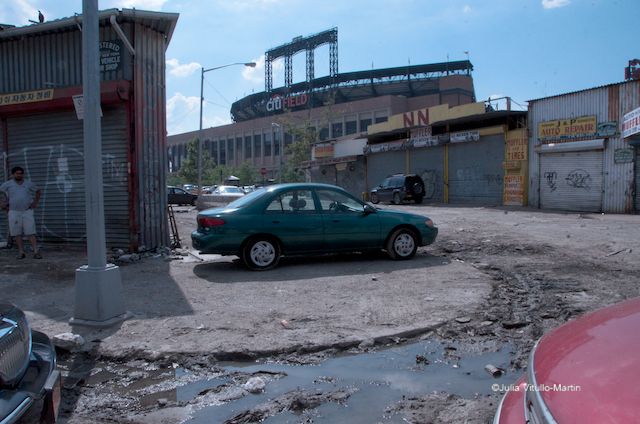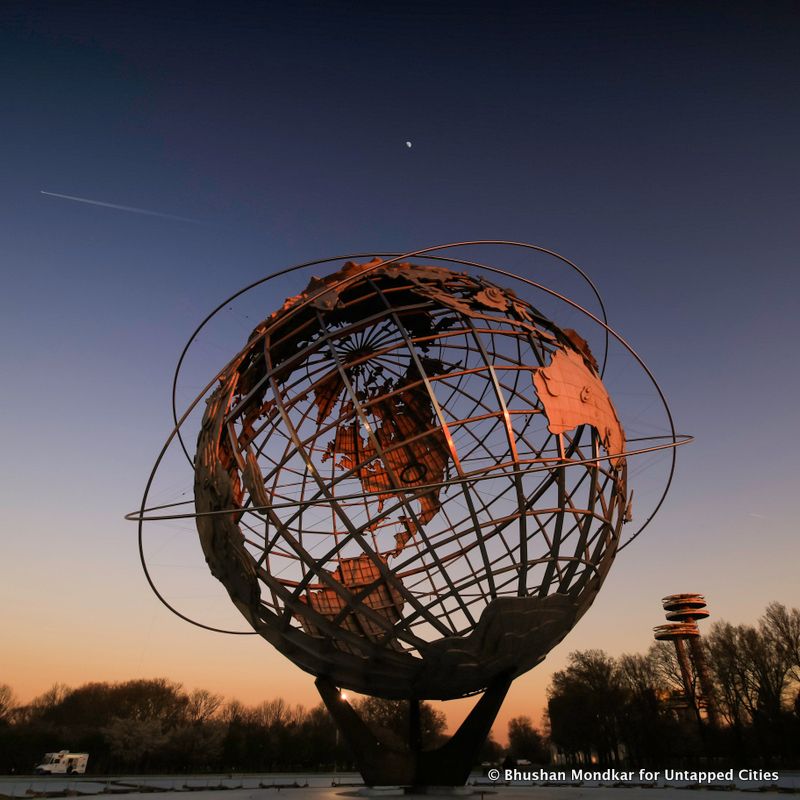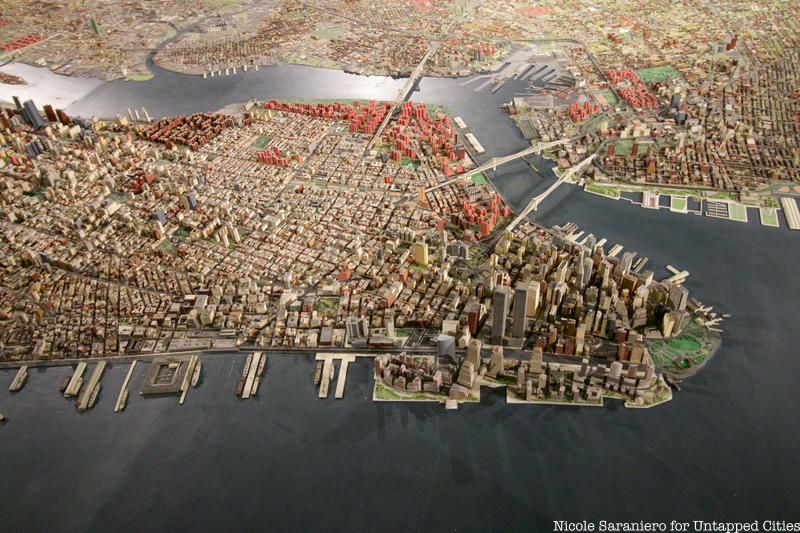Last Chance to Catch NYC's Holiday Notalgia Train
We met the voices of the NYC subway on our nostalgia ride this weekend!


It’s day one of the U.S. Open Tennis Championships, held at Flushing Meadows-Corona Park. For urban explorers, the park has long held a special lore, with its layered history and abandoned structures. As you’ll see in this collection of secrets, its past and proposed future continue to reflect the push and pull of New York City development and most spectacularly its hidden spots may reveal themselves in centuries to come, or never again.

Burial schematic from the record of Westinghouse Time Capsule I. Image from Wikimedia Commons.
On September 23, 1939, an 800-pound tube made of an alloy of copper and chromium called Cupaloy was lowered 50 feet into the ground at the site of the Westinghouse Electric & Manufacturing Company exhibit of the 1939-40 New York World’s Fair. The tube’s contents comprised 35 items one might find in any run-of-the-mill American family household, including copies of Life magazine, a Sears Roebuck catalog, cigarettes and seeds of wheat, corn, alfalfa and soy, each examined and preserved in inert argon and nitrogen gas to remain intact for the next five thousand years–until the year 6939 to be exact.
The device was an engineering feat, a “time capsule” as notable New York public relations counselor George Edward Pendray called it for the very first time in 1939. We’ll just have to wait another 4900+ years to see it again.

A view from inside an underground home in Colorado similar to Jay Swayze’s exhibit at the 1964 World’s Fair (from the exhibit’s souvenir brochure).
At the 1964 World’s Fair at Flushing Meadows, buried between the Hall of Science and the Port Authority Heliport, was a underground luxury home and bomb shelter. Texan developer Jay Swayze came up with the concept for his luxury bomb shelter as a response to the Cuban Missile Crisis and mounting Cold War anxieties in America. He wished to update the bland, cramped quarters of many existing bomb shelters in favor of more livable if albeit more extravagant accommodations.
The subterranean home had total of 500,000 to a million visitors according to Swayze and Fair organizers. Visitors were required to descend a short staircase in order to access the 5,600 square feet of nuke-proof luxury living space, which included three bedrooms and a 20-inch thick earth quake resistant steel shell. There was a Steinway piano in the living room, an air system, adjustable lighting to simulate time of day and season and a fake garden.
The underground home was supposedly demolished after the World’s Fair had closed down but many people, such as historian Dr. Lori Walters, believe that part of the exhibit remains and in 2014, she applied for permits in 2014 from the Parks Department to locate the structure using ground-penetrating radar. No news has come since…

Modern media has etched into our brains the aerial views of the U.S. Open Tennis Championships at Flushing Meadows-Corona Park from the Good Year blimp, but the original location was actually at the Forest Hills Tennis Club, where a stadium that still stands. The first U.S. Open was played there in 1915 and has hosted tennis icons like Billie Jean King, Margaret Court and Bill Tilden, musicians like Frank Sinatra, Bob Dylan and the Beatles in the 1960s, along with a shooting and bomb threat during a particularly scandalous 1977 season.
In 1978, the tournament moved to the much larger space in Flushing Meadows and the Forest Hills Tennis Stadium declined into a tired-looking remnant of its past. Though previously threatened with demolition, the stadium was renovated and repurposed following a preservation effort led in part by the Rego-Forest Preservation Council. Since its reopening in 2013, the Forest Hills Tennis Stadium has hosted musical acts like Mumford & Sons, Ed Sheeran and The Who.

Corona Ash Dump. Photo from New York City Parks Photo Archive.
In literature, the Corona Ash Dump was immortalized and romanticized by F. Scott Fitzgerald in The Great Gatsby as the “valley of ashes.” It was where the city’s coal burning refuse–the ash–was taken, along with garbage. On a former marshland rose dusty, high mounds (one at 100 feet was dubbed Mount Corona) through which the Long Island Railroad ran, along with Grand Central Parkway. Scavenging by both humans and rats was a common occurrence.
The Corona Ash Dump was an eyesore for the wealthy commuters coming in from the Gold Coast and like many other undesirable areas targeted by Robert Moses, the Corona Ash Dumps would undergo a massive transformation. Residents and businesses would be evicted and a high-profile event–the 1939 World’s Fair–would hasten changes. As reported by Urban Omnibus, “In creating a monumental park out of the Corona Ash Dumps, Moses likened himself to the prophet Isaiah in his quest to ‘Give unto them beauty for ashes.'”

Not all of the Corona Ash Dump was revitalized by Robert Moses. The area known as Willets Point became a gritty home to auto body and chop shops, junk and salvage yards, construction businesses, warehouses, and towing. There is also an MTA storage yard and the privately owned House of Spices, the nation’s largest distributor of Indian foods.
But history repeats itself, and evictions are coming with the looming Willets Point redevelopment plan, approved by the City Council in 2013. Calling Willets Point’s 75-acre triangle of land “New York’s next great neighborhood” and “a historic redevelopment effort,” the administration plan promises “retail and entertainment amenities, a hotel and convention center, mixed-income housing, public open space, and community uses.”
Read more about the history and future of Willets Point here.

For decades, the Philip Johnson-designed New York State Pavilion from the 1964 World’s Fair sat degrading from the elements. In recent years, a preservation movement, including the documentary A Modern Ruin and an uber-active community group on Facebook, has finally started to make headway–from a brief reopening of the structure on the 5oth anniversary, rehabilitation of the floor, and a new paint job. Of the controversial historic buildings in the city, the New York Pavilion has perhaps inspired the most passion from New Yorkers and preservationists alike in recent memory. The structure is a national and state landmark, but not a city landmark but with recent support from the borough of Queens and the city, it seems that the New York Pavilion may be saved from the wrecking ball at least.

Scaling the observation towers of the New York State Pavilion is usually on a New York City urban explorer’s to-do list, along with the unfortunate flurry of teenagers trespassing to spray graffiti. Photos by Robert Fein, seen in this previous article, also show the remnants of the VIP deck and other spaces in the towers. Fein hopes his photographs will further spur the movement to preserve and rehabilitate the pavilion. See more photos here.

The Unisphere is the largest globular structure built by man, weighing 700,000 pounds with a base that weighs 200,000 pounds. The Queens Chronicle also reports that is the “largest structure fabricated entirely with stainless steel,” and the sculpture itself was donated by U.S. Steel as the symbol for the 1964 World’s Fair.
Of more dispute are the rings on the Unisphere. The official NYC Landmarks Preservation report writes that the stainless steel rings denote the first manmade satellites. The book Meet Me at the Fair: A World’s Fair Reader states that the three rings supposedly represent the flightpaths of three historical moments in space travel: the first of the Russian, Yuri Gagarin, who was the first person to fly in space; that of John Glenn, the first American to orbit the earth; and the path of Telstar, the first communications satellite, launched in 1962. However, in the book, this fact is mistakenly attributed to the same NYC Landmarks Preservation report (above) by footnote, and the Wikipedia entry also echoes this (likely) misinformation. Many popular online sources also ascribe to the Gagarin/Glenn/Telstar theory.
To support the satellite ring theory, there is also a letter (available in the New York World’s Fair archive at the New York Public Library) from Unisphere designer Gilmore D. Clarke to Robert Moses that explained the original intent: to have rings representing each satellite in orbit–but there were too many for the sculpture and the three rings became symbolic representations of the satellites. There was also a study done that proposed moving and lighted satellites on the Unisphere, but that was also deemed too expensive.

The Panorama of the City of New York at the Queens Museum of Art is a scale model of all five boroughs, where an inch in the model is equal to a hundred feet in the actual city, allowing one to cover miles of sightseeing in only a few steps. To give you an idea of the scale, the Empire State Building is 15 inches tall. All 321 square miles of New York City are condensed into 9,335 square feet. Every building constructed before 1992 on every borough is represented in the model. It is also the world’s largest architectural model.
To fund the maintenance of the model, the Queens Museum launched the “Adopt-A-Building” program, where people can “buy” New York City real estate starting at $50.

Photo from New York City Parks Photo Archive.
During the 1964 World’s Fair, an AMF monorail ran, looking particularly futuristic because of its suspended system. Helmut Eppich writes that there are “humps swelling up from the ground at the lake area near the highways. Apparently, those large humps are the monorail support pylon foundations. Or what’s left.”

Numerous organizations, including NYC Parks, the Queens Museum, and the Design Trust for Public Space are seeking ways to better connect the park, traditionally cut off by highways and large-scale infrastructure, to neighboring communities. A 2015 exhibit at the Queens Museum displayed concepts developed by the community in this latest civic-led approach to improvements in the park. Entitled You Are Here: Creating a New Approach to Civic Participation in the World’s Park, the exhibition is the culmination of the first phase of The World’s Park: Reconnecting a Regional Park with Its Neighbors, a community engagement partnership.

Sitting in front of the Queens Hall of Science in Flushing Meadows-Corona Park is a bronze sculpture, 6 feet in diameter. The museum itself is one of the few survivors of the 1964 World’s Fair in Flushing Meadows-Corona Park. After the museum fell into disrepair, it was renovated and opened in 1984. The Sun Sculpture, unveiled in 2003, is roughly 13 feet in diameter and weighs 25,000 pounds. The sundial provides an appropriate introduction to the museum as children learn its function as both clock and impromptu playground, often using it as a makeshift fort.

Another, more famous sculpture from the World’s Fair–the Rocket Thrower–received a much-needed rehabilitation in 2013.
Next, read about the Top 10 Secrets of. This article co-written by Michelle Young, Jinwoo Chong, Julia Vitullo-Martin, Haley Johnston, Nasha Virata and Douglas Capraro.
Subscribe to our newsletter